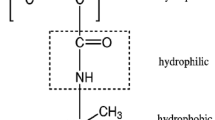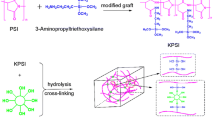Abstract
Poly(N-isopropylacrylamide) (PNIPAAm) hydrogels containing N-[3-(N,N-dimethylamino)propyl]methacrylamide (DMAPMAAm), 2-(N,N-dimethylamino)ethyl methacrylate (DMAEMA) and [3-(methacryloylamino)propyl]trimethylammonium chloride (MAPTAC) as cationic monomers were cross-linked with N,N’-methylenebisacrylamide (BIS) and tetraallylammonium bromide (TAB). The swelling degrees, uniaxial compression moduli and L-ascorbic acid (L-AA) releases of these cationic PNIPAAm hydrogels synthesized in 1,4-dioxane were compared with the one prepared in distilled–deionized water (DDW) and in aqueous sodium hydroxide solution (0.1 N NaOH). P(NIPAAm-co-MAPTAC)/BIS and P(NIPAAm-co-DMAEMA)/BIS hydrogels at 37 °C in DDW and at 37 °C/pH 4 exhibited higher gel strengths and compressive moduli than all the others cross-linked and copolymerized with TAB and DMAPMAAm, respectively. All the observations indicated that the physical cross-linking points created by ionomer pairs of MAPTA+Cl− units and the hydrophobic contributions of ester groups in the DMAEMA units might be a reason of their improved mechanical properties in DDW at 37 °C. Further, the charge screening effect of chloride ions in the swelling medium at pH 4 also resulted in the improved compressive moduli compared to the ones in DDW. The water diffusion into/from all the copolymeric PNIPAAm hydrogels during the swelling/deswelling processes at 25 °C/37 °C in DDW and their L-AA releases at 37 °C in DDW also revealed the importance of these ionic and hydrophobic effects. Water transport through the ones cross-linked with TAB was controlled by non-Fickian process due to the repulsive forces between the quaternized ammonium groups on the chemical cross-links while in the case of P(NIPAAm-co-MAPTAC)/BIS, water transport followed Fickian diffusion because the multiplet formations behaved as additional cross-links. Furthermore, P(NIPAAm-co-MAPTAC)/BIS hydrogel due to the ionomer-multiplet transitions at 37 °C in DDW has exhibited less-Fick diffusion that resulted in a lower diffusion coefficient during the release of L-AA as compared to the others.









Similar content being viewed by others
References
Schild HG (1992) Poly(N-isopropylacrylamide): experiment, theory and application. Prog Polym Sci 17:163–249
Bae YH, Okano T, Kim SW (1990) Temperature dependence of swelling of crosslinked poly(N, N’-alkyl substituted acrylamides) in water. J Polym Sci Polym Phys 28:923–936
Inomata H, Wada N, Yagi Y, Goto S, Saito S (1995) Swelling behaviours of N-alkylacrylamide gels in water: effects of copolymerization and crosslinking density. Polymer 36:875–877
Yu H, Grainger DW (1993) Thermo-sensitive swelling behavior in crosslinked N-isopropylacrylamide networks: cationic, anionic, and ampholytic hydrogels. J Appl Polym Sci 49:1553–1563
Soppimath KS, Aminabhavi TM, Dave AM, Kumbar SG, Rudzinski WE (2002) Hydrogels as novel drug delivery systems. Drug Dev Ind Pharm 28:957–974
Ahiabu A, Serpe MJ (2017) Rapidly responding pH- and temperature-responsive poly(N-isopropylacrylamide)-based microgels and assemblies. ACS Omega 2:1769–1777
Park TG (1999) Temperature modulated protein release from pH/temperature-sensitive hydrogels. Biomaterials 20:517–521
Wang B, Xu XD, Wang ZC, Cheng SX, Zhang XZ, Zhuo RX (2008) Synthesis and properties of pH and temperature sensitive P(NIPAAm-co-DMAEMA) hydrogels. Colloid Surf B 64:34–41
Mishra RK, Ray AR (2011) Synthesis and characterization of poly{N-[3-(dimethylamino)propyl] methacrylamide-co-itaconic acid} hydrogels for drug delivery. J Appl Polym Sci 119:3199–3206
Chen J, Liu M, Chen W, Zhang N, Zhu S, Zhang S, Xiong Y (2011) Synthesis, swelling and drug-release behaviour of a poly(N, N-diethylacrylamide-co-(2-dimethylamino)ethyl methacrylate) hydrogel. J Biomater Sci, Polym Ed 22:1049–1068
Wei W, Qi X, Li J, Zhong Y, Zuo G, Pan X, Dong W (2017) Synthesis and characterization of a novel cationic hydrogel base on salecan-g-PMAPTAC. Int J Biol Macromol 101:474–480
Echeverría C, Aragón-Gutiérrez A, Fernández-García M, Muñoz-Bonilla A, López D (2019) Thermoresponsive poly(N-isopropylacrylamide-co-dimethylaminoethyl methacrylate) microgel aqueous dispersions with potential antimicrobial properties. Polymers 11:606
Ramos J, Forcada J, Hidalgo-Alvarez R (2013) Cationic polymer nanoparticles and nanogels: from synthesis to biotechnological applications. Chem Rev 114:367–428
Sigolaeva L, Pergushov D, Oelmann M, Schwarz S, Brugnoni M, Kurochkin I, Richtering W (2018) Surface functionalization by stimuli-sensitive microgels for effective enzyme uptake and rational design of biosensor setups. Polymers 10:791
Han D, Lu Z, Chester SA, Lee H (2018) Micro 3D printing of a temperature-responsive hydrogel using projection micro-stereolithography. Sci Rep 8:1963
Beltran S, Hooper HH, Blanch HW, Prausnitz JM (1990) Swelling equilibria for ionized temperature sensitive gels in water and in aqueous salt solutions. J Chem Phys 92:2061–2066
Mishra RK, Ramasamy K, Ban NN, Majeed ABA (2013) Synthesis of poly[3-(methacryloylamino)propyl trimethylammonium chloride-co-methacrylic acid] copolymer hydrogels for controlled indomethacin delivery. J Appl Polym Sci 128:3365–3374
Halperin A, Kröger M, Winnik FM (2015) Poly(N-isopropylacrylamide) phase diagrams: fifty years of research. Angew Chem Int Ed 54:15342–15367
Deen GR, Mah CH (2016) Influence of external stimuli on the network properties of cationic poly(N-acryloyl-N’-propyl piperazine) hydrogels. Polymer 89:55–68
Cooperstein MA, Canavan HE (2013) Assessment of cytotoxicity of (N-isopropyl acrylamide) and poly(N-isopropyl acrylamide)-coated surfaces. Biointerphases 8:19
Uz M, Altinkaya SA, Mallapragada SK (2017) Stimuli responsive polymer-based strategies for polynucleotide delivery. J Mater Res 32:2930–2953
Bellotti E, Fedorchak MV, Velankar S, Little SR (2019) Tuning of thermoresponsive pNIPAAm hydrogels for the topical retention of controlled release ocular therapeutics. J Mater Chem B 7:1276–1283
Kozbekçi C, Şenkal BF, Erbil C (2017) Compressive moduli and network parameters of N-isopropylacrylamide hydrogels copolymerized by monoesters of itaconic acid and crosslinked with tetraallylammonium bromide. J Appl Polym Sci 134:45039
Korsmeyer RW, Gurny R, Doelker E, Buri P, Peppas NA (1983) Mechanisms of solute release from porous hydrophilic polymers. Int J Pharm 5:25–35
Ritger PL, Peppas NA (1987) A simple equation for description of solute release. I. Fickian and non-Fickian release from non-swellable devices in the form of slabs, spheres, cylinders or discs. J Control Rel 5:23–36
Alfrey T Jr, Gurnee EF, Lloyd WG (1966) Diffusion in glassy polymers. J Polym Sci Pol Phys 12:249–261
Brazel CS, Peppas NA (1999) Mechanisms of solute and drug transport in relaxing swellable, hydrophilic glassy polymers. Polymer 40:3383–3398
van de Wetering P, Moret EE, Schuurmans-Nieuwenbroek NM, van Steenbergen MJ, Hennink WE (1999) Structure-activity relationships of water-soluble cationic methacrylate/methacrylamide polymers for nonviral gene delivery. Bioconj Chem 10:589–597
Weaver LG, Stockmann R, Thang SH, Postma A (2017) Temperature-responsive methacrylamide polyampholytes. RSC Adv 7:31033–31041
Van de Wetering P, Zuidam NJ, Van Steenbergen MJ, Van der Houwen OAGJ, Underberg WJM, Hennink WE (1998) A mechanistic study of the hydrolytic stability of poly(2-(dimethylamino)ethyl methacrylate). Macromolecules 31:8063–8068
Yalçın B, Erbil C (2018) Effect of sodium hydroxide solution as polymerization solvent and activator on structural, mechanical and antibacterial properties of PNIPAAm and P(NIPAAm–clay) hydrogels. Polym Compos 39:386–406
Zhang S, Shi Z, Xu H, Ma X, Yin J, Tian M (2016) Revisiting the mechanism of redox-polymerization to build the hydrogel with excellent properties using a novel initiator. Soft Matter 12:2575–2582
Si K, Guo XQ, Qiu KY (1995) Initiation mechanism of radical polymerization using ammonium persulfate and polymerizable amine redox initiators. J Macromol Sci A 32:1149–1159
Guo XQ, Qiu KY, Feng DX (1990) Studies on the kinetics and initiation mechanism of acrylamide polymerization using persulfate/aliphatic diamine systems as initiator. Makromol Chem 191:577–587
Feng XD, Guo XQ, Qiu KY (1988) Study of the initiation mechanism of the vinyl polymerization with the system persulfate/N, N, N’, N’-tetramethylethylenediamine. Makromol Chem 189:77–83
An SW, Thirtle PN, Thomas RK, Baines FL, Billingham NC, Armes SP, Penfold J (1999) Structure of a diblock copolymer adsorbed at the hydrophobic solid/aqueous interface: effects of charge density on a weak polyelectrolyte brush. Macromolecules 32:2731–2738
Haq MA, Su Y, Wang D (2017) Mechanical properties of PNIPAM based hydrogels: a review. Mater Sci Eng C-Mater 70:842–855
Saeidi A, Katbab AA, Vasheghani-Farahani E, Afshar F (2004) Formulation design, optimization, characterization and swelling behaviour of a cationic superabsorbent based on a copolymer of [3-(methacryloylamino)propyl]trimethylammoniumchloride and acrylamide. Polym Int 53:92–100
Khokhlov AR, Kramarenko EY (1994) Polyelectrolyte/ionomer behavior in polymer gel collapse. Macromol Theory Simul 3:45–59
Miquelard-Garnier G, Creton C, Hourdet D (2008) Strain induced clustering in polyelectrolyte hydrogels. Soft Matter 4:1011–1023
Starodubtsev SG, Vasilevskaya VV, Khokhlov AR (2008) In: Galaev I, Mattiasson B (eds) Smart polymers: applications in biotechnology and biomedicine, 2nd edn. CRC Press Taylor & Francis Group, Boca Raton, p 92
Korpe S, Erdoğan B, Bayram G, Ozgen S, Uludag Y, Bicak N (2009) Crosslinked DADMAC polymers as cationic super absorbents. React Funct Polym 69:660–665
Baker JP, Hong LH, Blanch HW, Prausnitz JM (1994) Effect of initial total monomer concentration on the swelling behavior of cationic acrylamide-based hydrogels. Macromolecules 27:1446–1454
Trigo RM, Blanco MD, Huerta P, Olmo R, Teijón JM (1993) L-Ascorbic acid release from PHEMA hydrogels. Polym Bull 31:577–584
Martinez-Ruvalcaba A, Sanchez-Diaz JC, Becerra F, Cruz-Barba LE, Gonzalez-Alvarez A (2009) Swelling, characterization and drug delivery kinetics of polyacrylamide-co-itaconic acid/chitosan hydrogels. Express Polym Lett 3:25–32
Author information
Authors and Affiliations
Corresponding author
Rights and permissions
About this article
Cite this article
Şimşek, C., Eroğlu, Z.E. & Erbil, C. Effect of ionomer/multiplet formation on mechanical properties and ascorbic acid release behavior of PNIPAAm hydrogels copolymerized by DMAEMA, DMAPMAAm and MAPTAC. Iran Polym J 28, 977–990 (2019). https://doi.org/10.1007/s13726-019-00762-y
Received:
Accepted:
Published:
Issue Date:
DOI: https://doi.org/10.1007/s13726-019-00762-y




